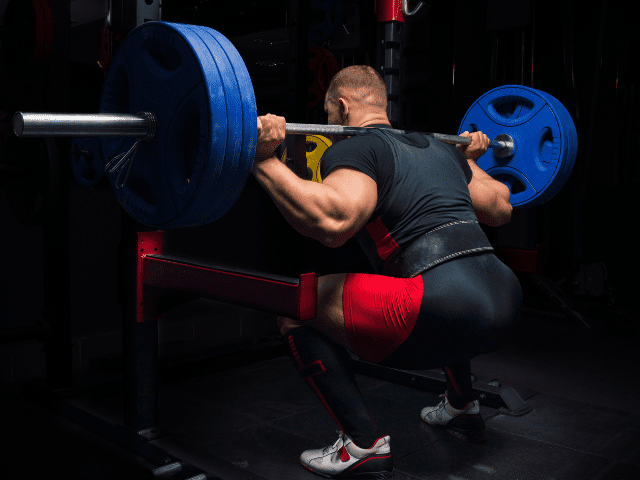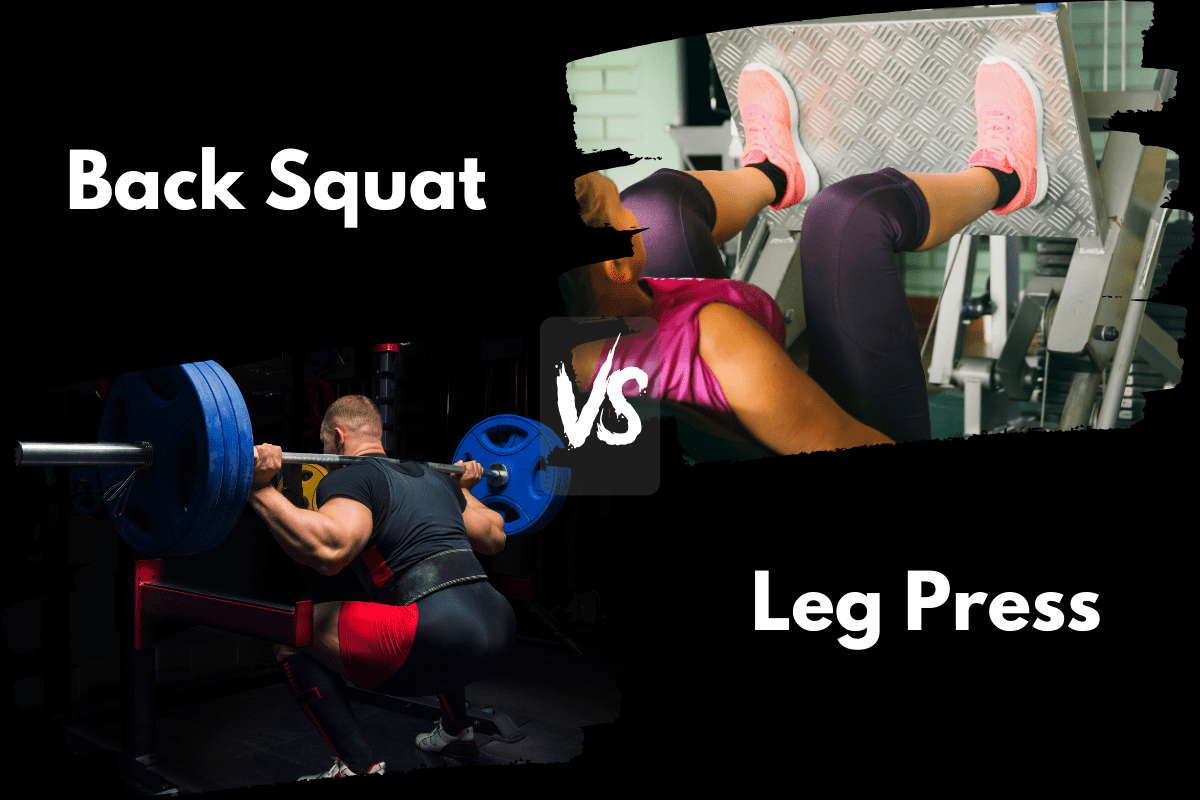Back Squat vs Leg Press: Which Leg Exercise is Superior?
The Back Squat and Leg Press are two popular exercises used to strengthen and build mass in the lower body, specifically the quadriceps, glutes, and hamstrings. While both exercises can be effective for these muscle groups, they differ in terms of their movement patterns, benefits, and potential drawbacks.
I’ve been a D1 College Strength Coach for two decades and in this article, I will cover the benefits of each exercise, as well as how to properly execute them to avoid injury and maximize results.
I will also compare the Back Squat and Leg Press to help you decide which exercise is best for your training goals and individual needs. Whether you are a beginner or an experienced lifter, this guide has something for you.
Back Squat

Equipment Needed
- Squat Rack
- Barbell
Setup
In setting up for the Back Squat, athletes choose between the high bar and low bar position. (Personally, I teach a high bar position with athletes)
Regardless of bar placement, the athlete should actively pull their shoulders together and back in order to both create a shelf for the barbell to rest on. This is also to generate as much upper body tension as possible in order to maintain a consistent torso position for the duration of the lift.
A good cue here is to have the athlete pin their elbows down by their sides, similar to the bottom position of a Lat pulldown, before placing the bar on their shoulders.
Generally speaking, the athlete should place their hands as close together as comfortably possible, which helps maintain the aforementioned upper body tightness and shelf for the barbell to rest on.
Certain athletes will experience pain in either their shoulders, elbows, or wrists when setting up for the back squat. Most athletes can work through these issues and squat comfortably by adopting different combinations of the following variables: bar position (high bar and low bar), hand width (wider/more narrow), or adopting a grip with their thumbs over or under the bar.
After setting up properly, the athlete un-racks the bar and walks it out of the uprights, takes a big breath in, braces their core, and initiates the eccentric portion of their squat.
Eccentric
While maintaining a tight brace in their core and tension in their upper back (as mentioned in the setup paragraph), the athlete initiates downward motion of the bar via simultaneous hip and knee flexion until the crease of their hip goes below the knee.
The especially important part of the range of motion is taking the muscle to its full eccentric length, demonstrating that athletes further benefit by taking their squats to the deepest depth that their mobility allows. Once the athlete reaches their lowest position in the squat, they transition from the eccentric to concentric portion.
Concentric
The concentric portion of the squat involves the athlete rising out of the hole via a combination of knee and hip extension.
In rising out of the hole, athletes commonly experience sticking points either in the hole or when they are just above parallel. These can vary based on each athlete’s relative strengths and weaknesses, or some technical errors to be addressed later. Once the athlete completes the rep, they exhale, and either initiate the next rep or re-rack the bar.
Re-rack
Upon completing the last rep of their set, the athlete should maintain their brace, and walk the bar back into the uprights.
Coaching Points
The heels coming up during the squat is a common technical error at the bottom of the squat, where the bar comes forward of the athlete’s center of mass and forces them to lift their heels off the ground.
Two common fixes for this are to have the athlete sit back into the squat to keep their balance over their mid-foot, and to have the athlete actively pull the bar down into their back using their lats.
Athletes who are still having trouble due to poor ankle dorsiflexion, long femur length relative to their height, or a combination of both, can use a device to elevate their feet such as weightlifting squat shoes, an angled plate, or 2.5lb weights to help address the issue.
Benefits
The Back Squat helps improve overall athletic performance, as it trains the muscles used in activities such as running, jumping, and lifting. Other potential benefits of the Back Squat include:
- Increased muscle size and strength: The Back Squat targets large muscle groups in the lower body, which can lead to increased muscle size and strength over time.
- Improved mobility and flexibility: Squatting requires a full range of motion in the hips, knees, and ankles, which can help improve mobility and flexibility in these joints.
- Improved bone density: Resistance training, such as the Back Squat, has been shown to increase bone density, which can help reduce the risk of osteoporosis and other bone-related conditions.
- Enhanced cardiovascular fitness: The Back Squat can be performed with high reps and moderate to high intensity, which can provide a cardiovascular challenge and improve overall fitness.
It’s important to note that the benefits of the Back Squat can vary depending on individual factors, such as training experience and strength.

Tired of coming up with your own workouts? But don’t want to pay an arm and a leg?
I post workouts 5 days a week right here. (Did I mention they’re free?)
Leg Press

Equipment Needed
- Leg Press Machine
How To / Coaching Points
Instructions on how to Leg Press are going to be extremely dependent on the machine itself. All Leg Press machines do not function in the same way. It’s actually quite the opposite. I would guess there are at least a dozen different designs that all work differently.
With that being said, instead of specific instructions, I’m going to give you some somewhat universal tips when it comes to Leg Press.
- If using a Leg Press Machine you’re unfamiliar with, always start with no weight on the machine.
- Make sure you know how to unrack and rack the safeties as well as do a full rep before adding weight to the machine.
- Go up in weight slowly. No need to make a big jump and get yourself pinned and potentially hurt.
- Do NOT overextend your knees. Learn how to fully extend your legs without locking out your knees.
Benefits
The main benefit of a Leg Press is that you can build leg strength without having to load weight on your back (axial load). This is extremely beneficial for anyone who may have back issues that prevent them from being able to Back Squat or even Front Squat.
Leg Press can also be beneficial for beginner lifters who are not yet comfortable with their Back Squat technique. I would rather have a beginner Leg Press safely rather than Back Squat with improper form.
Looking for more alternatives and Leg Press variations other than just Back Squat? Here are 10 of my favorite alternatives for Leg Press.
Back Squat vs Leg Press: Which is Better?
Now, let’s take a side-by-side look at both the Leg Press and Back Squat to see if one is better than the other for a few common lifting goals.
Better For Developing Size and Strength: Back Squat

Not only is the Back Squat better than Leg Press for developing strength and muscle mass, but in my opinion, it’s the best exercise for building pure strength and size.
The Back Squat is a compound exercise that involves multiple joints and all the lower body muscle groups, including the hips, knees, and ankles. It requires more coordination and stability, and recruits more muscle fibers, resulting in greater overall muscle activation and growth.
In contrast, the Leg Press is often done seated with the weight moving on a fixed plane. So, you miss many of the benefits that Back Squats provide for the core and stabilizer muscles.
Better For Beginners: Leg Press
There are a few reasons why the Leg Press may be considered better than Back Squats for beginners.
The Leg Press is generally easier to perform than a Barbell Squat, especially for those who are new to lifting. It involves less coordination and stability and does not require the use of a barbell, making it more accessible and user-friendly.
In contrast, the Back Squat demands proper technique and form to avoid injury, which can take longer for beginners to learn.
Don’t get me wrong, I believe beginners should learn the proper Back Squat technique early on because Back Squats can provide so much value. But, I would rather a beginner Leg Press safely as opposed to Back Squatting with improper technique.

Get Shredded… For Free
Get a free workout Monday through Friday, posted right here on Horton Barbell. These workouts are designed to help you get strong, in shape and look great at the beach!
Final Thoughts
I’ve just spent the last section of this article comparing which is better – Back Squat vs Leg Press. I love Back Squats and believe it’s one of the most beneficial exercises an athlete (and non-athletes) can do.
However, if you’re unable to squat because of a physical limitation or you’re not comfortable with your Back Squat technique then Leg Press can make a good substitute.
More Links and Info
Check out how the Leg Press and Barbell Squat compare against some other popular lower body exercises:

